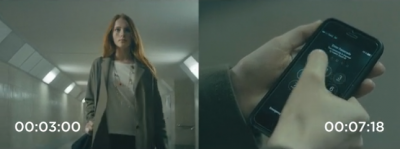CW: Discussion of assault
“It happened in the light of day, in a safe neighborhood, 200 feet from a police station.” Cut to a disembodied torso, a hand caressing the scars up the abdomen, panning up to a scarred chest and a woman with a soft expression. She is Kathy Roma, and in 2000 she was attacked by a stranger in broad daylight and stabbed repeatedly. Now, she serves as communications director for Nimb, “a smart ring that keeps you safe and sound.” The developers are currently raising funds on Kickstarter, with $186,530, far exceeding their goal of $50,000.
Nimb is the Life Alert all grown up, a fashion-forward wearable marketed to young college women, worried parents, those with disabilities, the elderly, and basically any other person living in an uncertain and terrifying world. The ring, which comes in Classic White or Stealth Black, connects to a smart phone via Bluetooth. When the wearer feels in danger and cannot otherwise seek help, a small button on the underside of the ring will alert their chosen networks and send GPS coordinates to potential saviors. Nimb has received international media coverage, and the fact that it blew the original Kickstarter goal out of the water shows how in-demand this sort of device is.
The project deftly addresses potential criticisms before they can even be voiced. The “safety circles” feature allows users to choose whom they notify with the panic button. When first seeing the project, I assumed police or emergency responders would be the default, but Nimb allows users to customize who receives an alert, whether friends, family members, a single individual, emergency services, or even those nearby.
The emphasis is on “community.” They tout the ring’s ability to give the user control over who receives panic notifications. They call this feature “crowd source security” and “believe that society’s ready to protect itself.” The subtle implication is that, rather than relying on institutional apparatuses such as 911 services, individuals can reach out to social networks when they need help.
While the promotional material features some diversity of Nimb wearers, specifically a few women of color, children, and elderly people, the dominant figures in the videos and images are young white women. Kathy Roma states in the Kickstarter video that her young adult daughter wears one, and goes to “crazy parties.” “I let her go with a lighter heart,” Roma declares, watching her daughter walk away and looking down lovingly at her Classic White Nimb. “I embrace the unknown while feeling safe and secure.”
I can think of no better articulation of the hopes and dreams of people living in what is often termed “The Risk Society.”
Writing on modernity, Ulrick Beck and Anthony Giddens argue that the forces at work in a society governed by mass industry, science, and realism create a cultural condition of reflexive introspection and focus on the future, rather than the past. Citing environmental disasters such as Chernobyl and economic upheavals, theorists of the risk society illustrate how widespread precarity—be it material, ideological, or even symbolic—create a climate of anxiety and fear, often with no discernable object to fear or be anxious about.
While Nimb cites medical emergencies as one potential application for the panic ring, the overwhelming emphasis of the promotional material is on young, attractive white women in dark hallways and deserted streets. A 20-something, thin, light-skinned woman looks ominously over her shoulder in a poorly-lit tunnel, and two versions of herself emerge. One, desperately sorting through her large bag to find her purse, fumbling with the security code and dialing 911 only to get an automated hold message; the other, with the Nimb, calmly holds the panic button for three seconds and begins confidently walking from the unseen danger, never even looking back.
Of course, gendered violence is a real threat, and those of small stature are often easy targets for strangers on the street looking to do someone harm. But most assaults against women are perpetrated by people they know, not a stranger in a shadowy hallway. And a person of color with a gender non-conforming presentation walking down the street is significantly more likely to be attacked than nearly any other demographic. But domestic violence and folks with bodies that violate norms are notably absent from this, and many other discussions of public safety. The endangered white woman is a well-worn trope throughout Western civilization; it is a semiotic shorthand that easily writes its own narrative, and is therefore much more effective at selling products to a large demographic.
There also seems to be no possible accountability for activating such a device in a way that exploits both emergency services and one’s privilege to depend on them. Who gets to feel safe by calling the cops and who doesn’t is an important question, and while Nimb allows people to call for help without relying on police, it fails to address thosewho may have the police called on them. Nothing is going to stop the powerful from inflicting police violence on those with relatively less power, but this device will make it much easier for people to call the police in situations that do not require police intervention. Police intervention often makes a bad situation worse. Facilitating police intervention may be helpful to some, but at whose expense?

All of this is made more apparent in the promotional video on Kickstarter. The video conveniently elides the source of danger in the scene of the white woman activating her Nimb. She is alone in a (now) well-lit corridor, looking over her shoulder at something unseen. What is she seeing? Are you filling in the blanks? Without any apparent threat, a white woman has called the police.
In a risk society, we are constantly overwhelmed with the uncertainty and danger of the unknown. How we deal with that danger speaks volumes about our assumptions about other people and the institutions we depend on to give order and safety to our lives. I applaud the Nimb for not defaulting to police intervention, but ultimately that decision is in the hands of the user, and the technological affordances of the Nimb can be used as easily for good as for ill. And this is to say nothing of the private security forces also mentioned in the promotional materials.
“Crowd source security” is the inevitable manifestation of the risk society, in which even emergency forces cannot be trusted, and onlookers may be either absent or apathetic. A mother or partner with their own Nimb, a trusted friend who lives in the neighborhood and checks their texts frequently, or even a stranger nearby set up to receive Nimb notifications may be a person’s best bet when facing unclear, possibly present danger. Perhaps Nimb demonstrates that the closest we can get to care free living is by outsourcing that care to surveillance.
Britney is on Twitter.
All photos and screenshots in this essay are taken from the Nimb’s Kickstarter site.




